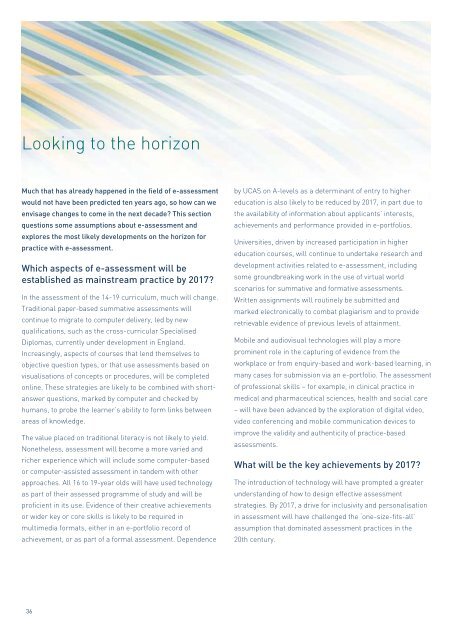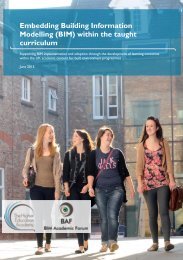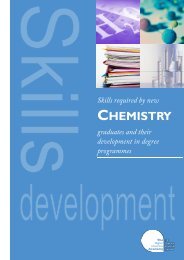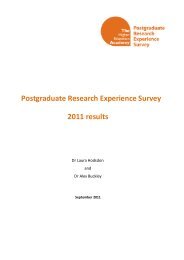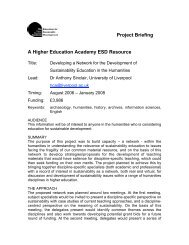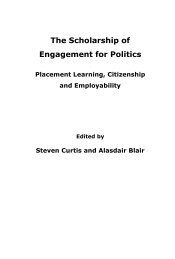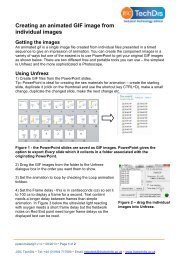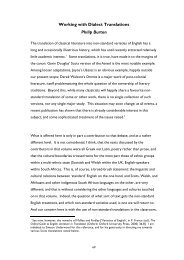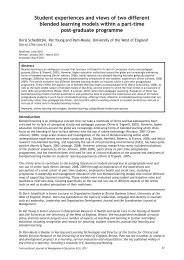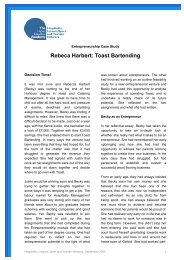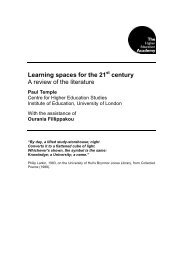Effective Practice with e-Assessment: An overview of ... - Jisc
Effective Practice with e-Assessment: An overview of ... - Jisc
Effective Practice with e-Assessment: An overview of ... - Jisc
Create successful ePaper yourself
Turn your PDF publications into a flip-book with our unique Google optimized e-Paper software.
Looking to the horizon<br />
Much that has already happened in the field <strong>of</strong> e-assessment<br />
would not have been predicted ten years ago, so how can we<br />
envisage changes to come in the next decade? This section<br />
questions some assumptions about e-assessment and<br />
explores the most likely developments on the horizon for<br />
practice <strong>with</strong> e-assessment.<br />
Which aspects <strong>of</strong> e-assessment will be<br />
established as mainstream practice by 2017?<br />
In the assessment <strong>of</strong> the 14-19 curriculum, much will change.<br />
Traditional paper-based summative assessments will<br />
continue to migrate to computer delivery, led by new<br />
qualifications, such as the cross-curricular Specialised<br />
Diplomas, currently under development in England.<br />
Increasingly, aspects <strong>of</strong> courses that lend themselves to<br />
objective question types, or that use assessments based on<br />
visualisations <strong>of</strong> concepts or procedures, will be completed<br />
online. These strategies are likely to be combined <strong>with</strong> shortanswer<br />
questions, marked by computer and checked by<br />
humans, to probe the learner’s ability to form links between<br />
areas <strong>of</strong> knowledge.<br />
The value placed on traditional literacy is not likely to yield.<br />
Nonetheless, assessment will become a more varied and<br />
richer experience which will include some computer-based<br />
or computer-assisted assessment in tandem <strong>with</strong> other<br />
approaches. All 16 to 19-year olds will have used technology<br />
as part <strong>of</strong> their assessed programme <strong>of</strong> study and will be<br />
pr<strong>of</strong>icient in its use. Evidence <strong>of</strong> their creative achievements<br />
or wider key or core skills is likely to be required in<br />
multimedia formats, either in an e-portfolio record <strong>of</strong><br />
achievement, or as part <strong>of</strong> a formal assessment. Dependence<br />
by UCAS on A-levels as a determinant <strong>of</strong> entry to higher<br />
education is also likely to be reduced by 2017, in part due to<br />
the availability <strong>of</strong> information about applicants’ interests,<br />
achievements and performance provided in e-portfolios.<br />
Universities, driven by increased participation in higher<br />
education courses, will continue to undertake research and<br />
development activities related to e-assessment, including<br />
some groundbreaking work in the use <strong>of</strong> virtual world<br />
scenarios for summative and formative assessments.<br />
Written assignments will routinely be submitted and<br />
marked electronically to combat plagiarism and to provide<br />
retrievable evidence <strong>of</strong> previous levels <strong>of</strong> attainment.<br />
Mobile and audiovisual technologies will play a more<br />
prominent role in the capturing <strong>of</strong> evidence from the<br />
workplace or from enquiry-based and work-based learning, in<br />
many cases for submission via an e-portfolio. The assessment<br />
<strong>of</strong> pr<strong>of</strong>essional skills – for example, in clinical practice in<br />
medical and pharmaceutical sciences, health and social care<br />
– will have been advanced by the exploration <strong>of</strong> digital video,<br />
video conferencing and mobile communication devices to<br />
improve the validity and authenticity <strong>of</strong> practice-based<br />
assessments.<br />
What will be the key achievements by 2017?<br />
The introduction <strong>of</strong> technology will have prompted a greater<br />
understanding <strong>of</strong> how to design effective assessment<br />
strategies. By 2017, a drive for inclusivity and personalisation<br />
in assessment will have challenged the ‘one-size-fits-all’<br />
assumption that dominated assessment practices in the<br />
20th century.<br />
36


